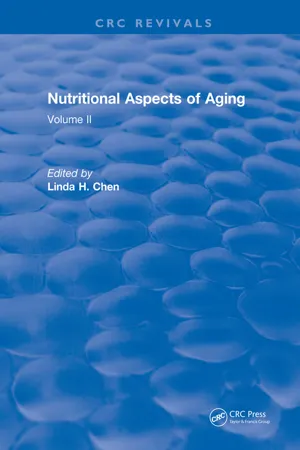![]()
Section II
Nutritional Basis for Diseases in Aging
![]()
Chapter 3
Cardiovascular Diseases
Kang-Jey Ho
Table of Contents
- I. Introduction
- II. Pathogenesis of Atherosclerosis
- III. Lipoprotein and Cholesterol Metabolism
- IV. Risk Factors for Atherosclerosis and Ischemic Heart Disease
- A. Age as a Risk Factor
- B. Male Predominance
- C. Obesity and Diabetes Mellitus
- D. Diet and Other Factors Affecting Plasma Lipid Levels
- 1. Diet
- 2. Chronic Renal Failure
- 3. Hypothyroidism
- E. Immunologic Senescence
- F. Other Factors Inducing Endothelial Injury
- 1. Hemodynamics
- 2. Chemicals
- V. Prevention and Management
- References
I. Introduction
Cardiovascular disease in the elderly might belong to one of the following three categories: (1) physiologic changes related to the aging process per se, (2) a specific pathologic process which is increased in frequency and severity with age, and (3) a combination of the above two. In fact, the distinction among these three categories for a particular entity of cardiovascular disease is often extremely difficult, if not impossible. Lipofucsin accumulation in the myocardium, an essential feature of so-called senile cardiomyopathy, is definitely related to the aging process.1 The amount of lipofucsin pigment increases progressively with age at an accumulation rate of 0.3% of the total heart volume per decade.2 By the time a person reaches 90 years of age, lipofucsin pigment may account for as much as 30% of the total solids of myocardial fibers. Amyloid deposit in the myocardium and basophilic degeneration of myocardial fibers are common but not universal findings in elderly persons. Endocardial fibrous thickening, valvular ring calcification, arrhythmia, cardiac enlargement, atrophy, and fibrosis cannot be considered as universal or even common results of aging. With advancing age, most vessels increase in both diameter and wall thickness, with fragmentation of elastic fibers and proliferation of collagen resulting in less extensibility of the vessel wall. The incidence and degree of hyalinization of arterioles also increase with age. However, it remains uncertain whether such changes are related to the aging process alone or its interaction with environmental factors.1,3,4
Regardless of how much aging per se contributes to the disease process, the most common and important cardiovascular diseases in the elderly patients are coronary heart disease, cerebrovascular accident, aortic aneurysm, occlusive peripheral vascular disease, and phlebothrombosis.4 All of these diseases, with the exception of venous thrombosis, are based primarily upon a single common pathologic process, atherosclerosis. Hypertension and its role in cerebrovascular accidents and congestive heart failure are discussed elsewhere in this book and will not be repeated here. The discussion in this chapter is focused on the basic disease process of atherosclerosis.
Atherosclerosis is a multifactorial disease; aging is only one of the many factors attributing to such a process. First reviewed is our current understanding of the pathogenesis of atherosclerosis, followed by identification of its risk factors, particularly those pertinent to the nutritional aspects of aging.
II. Pathogenesis of Atherosclerosis
The current concept of the pathogenesis of atherosclerosis is briefly summarized in Figure 1. The primary event initiating atherosclerosis is generally believed to be endothelial injury.5 Since naturally occurring atherosclerosis develops slowly over a period of decades, such endothelial injury must be subtle, repetitive, and chronic. Endothelium can be damaged by excessive shear stress of hemodynamic forces, particularly those associated with hypertension.8-15 Low-density lipoproteins (LDL) may cause functional endothelial injury as evidenced by both morphologic and physiologic alterations in the endothelium.17-21 Other chemicals and toxins, such as homocystine and bacterial endotoxins, can produce vascular injury and arterial thrombosis.22-24 Endothelium can also be damaged by immunologic means,25-28 viruses,29 hypoxemia,30 and many other factors yet to be identified.
The damaged endothelium becomes dysfunctional, disrupted, and even desquamated.6 Endothelial dysfunction leads to the loss of its thromboresistant mechanisms, such as the synthesis and secretion of glycocalyx,31 α2-macroglobulin,32 nonthrombotic type V surface collagen,33 prostacyclin,34,35 and plasminogen activator,36 and also the metabolism of thrombin and vasoactive amines,37,38 Endothelial denudation results in the direct exposure of subendothelial matrix, such as collagen (Types I and III), to the circulating blood elements. Adherence o...
